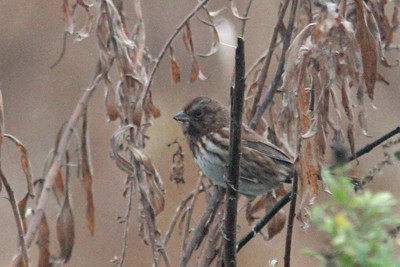Over the course of the morning I ran across not one but too oddly plumaged Song Sparrows. The first was at Arcadia and had a very dark face and upper breast and the second was in the East Meadows and that individual had white patches on both sides of its face below its eyes. Song Sparrows are somewhat variable in plumage but these two individuals are some of the oddest ones I have ever come across. Although not rarities it is always fun to capture odd individuals among the hordes of its more common brethren.
Besides the oddly plumaged Song Sparrows I ran across this morning there were a number of other notable species both at Arcadia and the East Meadows. Arcadia featured an American Coot in almost the exact spot I found one several days ago in the marsh, at least three American Woodcocks still displaying before dawn, a Bonaparte's Gull (no sign of the Franklin's Gull from yesterday), a late House Wren, at least eight Evening Grosbeaks, my first American Tree Sparrow of the fall (a true sign of the coming winter), at least four Fox Sparrows and several Palm Warblers. With a little time left before I headed home I made a brief stop in the East Meadows with the most unusual sighting being a Dunlin that dropped into a small puddle within just feet of me as I was leaving. So much more satisfying to see this species close up in decent weather than on a distant sandbar during a rainy day. It only stayed in the area for a few minutes before some gun shots scared it off to parts unknown.
The day also delivered another unusual species when I had at least one Common Redpoll fly over the house late in the afternoon. This species looks to be the next irruptive species to arrive in what has been a fantastic irruptive fall with large influxes of Purple Finches, Pine Siskins, Red Crossbills and Red breasted Nuthatches as well as increasing numbers of Evening Grosbeaks. Looking forward to seeing what the rest of fall into the winter brings us.











No comments:
Post a Comment